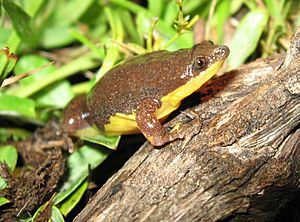Elachistocleis bicolor facts for kids
Quick facts for kids Elachistocleis bicolor |
|
|---|---|
 |
|
| Conservation status | |
| Scientific classification |
The two-colored oval frog (Elachistocleis bicolor) is a cool type of frog. People in Spanish-speaking countries sometimes call it rana pinguino or sapito panza amarilla. This frog belongs to the Microhylidae family.
You can find these frogs in several South American countries. They live in central Argentina, and further north in Paraguay and Uruguay. They also live in the Amazon parts of Brazil. Some older reports from Bolivia might have been about a different frog, Elachistocleis haroi.
Where These Frogs Live
Elachistocleis bicolor frogs are quite common. They like places that get flooded sometimes, like grasslands. You can also find them in both dry and wet forests. These adaptable frogs can even live in gardens in the countryside and in cities!
What They Look Like and Do
These frogs are mostly active at night, which means they are nocturnal. They also spend a lot of time underground, making them semi-fossorial. When it's very dry, they might go into a deep sleep called aestivation. During this time, you can find them hiding inside ant and termite nests.
Male Elachistocleis bicolor frogs are about 23 to 32 millimeters long. That's about the size of a small paperclip! Female frogs are a bit bigger, growing to about 27 to 36 millimeters. Their name, "two-colored," comes from their look. They have a brownish back and a yellowish belly, which makes them stand out.
These frogs mainly eat ants and termites. Other insects are only a small part of their diet. One study in Uruguay showed that termites were more important when the frogs were less active. But when they were active, ants (especially Pheidole and Solenopsis ants) were their main food.
How They Reproduce
Elachistocleis bicolor frogs lay their eggs during the wet season. They choose pools of standing water for this. A female frog can lay about 620 eggs! The more eggs she lays, the bigger she usually is. These eggs don't sink; they float right on top of the water.
See also
- In Spanish: Elachistocleis bicolor para niños


